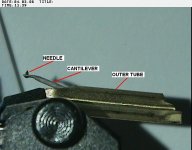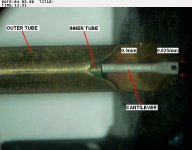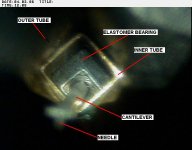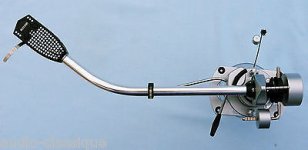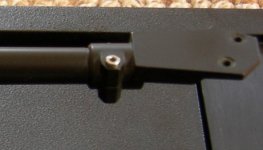Sure - I had meant to post the polar plot for sections of that track, with vertical only stimulus, but there's so many interesting things going on the forum right now, I got distracted !When time allows, can you post please the polar plot for the HFN S2 T3 as well.
Thank you again. 🙂
George
Anyways, here it is. Very interesting too.
The first polar plot attached below is for the section of the sweep near 8Hz, for direct comparison to the S2T2 (lateral stimulus) plot posted previously. The plot is somewhat similar, but has notable spectral content near 18Hz that isn't prominent in the lateral stimulus test
So I looked at the section of the S2T3 (vertical stimulus) sweep near 18Hz, shown in the second plot attached below. One can see what appears to be a pronounced resonant response in FM, nearly monotonic (looks like a bit of 2nd harmonic near 36Hz). FM due to headshell motion seems near certain as the explanation IMO.
Interesting, and very pretty ! It tallies with the classic spectral plots, IMO.
LD
Attachments
Last edited:
The lateral signal is so much less that it could even be down to channel imbalance.
I suppose real cartridges have very different horizontal and vertical compliance.
I suppose real cartridges have very different horizontal and vertical compliance.
This is a good question. There is at least one cartridge (the ortofon DJ S-120) that makes a marketing point of different compliance. And according to Walton, back in the 60s you had about half the vertical compliance to horizontal. Now, with a donut elastomer its only the suspension string (if you have one) which modifies the vertical compliance. Unsure how to model that though...
In FM, which is what is at issue for pitch stability, channel balance makes no difference to performance or measurement. L, R, mono, difference, all show identical FM results because it's just the relative linear velocity of stylus to groove that matters.The lateral signal is so much less that it could even be down to channel imbalance.
The difference observed here is due to mechanical stimulus to headshell motion being vertical in the case of S2T3 recorded file and lateral in the case of S2T2.
What makes for the difference here is the direction of headshell motion in response to direction of mechanical stimulus.
LD
Last edited:
Can anyone answer my query ? When you people speak of headshell movement. Do you mean movements at headshell end or at bearing end. Looks like Tonearm with unibody like Rega would be good choice if movements is at headshell end.
Regards.
An externally hosted image should be here but it was not working when we last tested it.
Regards.
At resonance things are not as stiff as they seem
https://www.youtube.com/watch?v=j-zczJXSxnw The tacoma narrows bridge.
https://www.youtube.com/watch?v=j-zczJXSxnw The tacoma narrows bridge.
Can anyone answer my query ? When you people speak of headshell movement. Do you mean movements at headshell end or at bearing end. Looks like Tonearm with unibody like Rega would be good choice if movements is at headshell end.
Movement at headshell.
A friend has a Rega 3. I may pick it up for a test run.
Anyways, here it is. Very interesting too.
Thank you Lucky.
This becomes very tempting to try the longhorn mod.
George
Cantilever suspension in Shure cartridges comprises a combination of an elastomeric donut between the magnet and the metal stylus housing, along with a metal support wire. From visual inspection, the cross-section shape of the housing and magnet (and thus elastomer) appears* to be very slightly rhombic, not a perfect square, with vertices aligned lateral and vertical. Thus, unequal compliance and damping in the lateral and vertical directions appears likely. In addition, the geometry of the tie wire appears intended to primarily provide vertical support, and will limit vertical compliance.
It seems reasonable to limit vertical compliance in order to raise stylus-arm resonance well above subsonic record warp frequencies. For several practical reasons, it is standard practice to mix program material to mono at lower frequencies when cutting a disc master. So there is limited vertical musical program to excite a LF resonance. Thus, limiting vertical compliance to raise the vertical resonance frequency makes engineering sense.
* These observations are purely from eyeball and drawings in promotional literature. We’d need a few sacrificial styli and calipers to confirm.
It seems reasonable to limit vertical compliance in order to raise stylus-arm resonance well above subsonic record warp frequencies. For several practical reasons, it is standard practice to mix program material to mono at lower frequencies when cutting a disc master. So there is limited vertical musical program to excite a LF resonance. Thus, limiting vertical compliance to raise the vertical resonance frequency makes engineering sense.
* These observations are purely from eyeball and drawings in promotional literature. We’d need a few sacrificial styli and calipers to confirm.
Attachments
Thanks Bill and gpapag.
Regards.
That would be very interesting to see the difference. Your efforts and also other contributors explaining this stuff is very much appreciated.A friend has a Rega 3. I may pick it up for a test run.
Regards.
I really should get around to getting my act together so I can measure on my SME309. Whilst this is detachable headshell, it has a studly clamp so would make a comparison. I can't remember if Hans has done a measurement off his Kuzma as that would be the most telling off a parallel tracking arm.
That would be very interesting to see the difference.
Thank you Hiten. Hopefully by next weekend.🙂
Whilst this is detachable headshell, it has a studly clamp so would make a comparison.
My SME3009 III Impr. has a fixed headshell. The classic spectral plots don’t show any improvement over a detachable headshell on the JVC arm.
George
For a given value of 'fixed' 🙂 You can rotate it with your fingers. Now if this actually makes any difference in the larger scheme of things IS a very interesting question. (note one day I would like a 3009 I in the collection)
Attachments
Last edited:
I am just learning so pardon if I am wrong.
Since these measurements are sensitive and minute, so to negate the variables of having different tonearm/setting and measurement taken over a period of time I wonder if we can just loosen the screws of cartridge (Not too loose just about enough to hold cartridge lightly) and loosen the bayonet headshell and take measurement before and after.
Regards.
Since these measurements are sensitive and minute, so to negate the variables of having different tonearm/setting and measurement taken over a period of time I wonder if we can just loosen the screws of cartridge (Not too loose just about enough to hold cartridge lightly) and loosen the bayonet headshell and take measurement before and after.
Regards.
(note one day I would like a 3009 I in the collection)
There may be better and very well acclaimed tonearms but for me SMEs are Design Classic. Wonder if we can put it in here.
Regards
well I am on a low mass kick. LD tells me off for this, but I don't care 🙂. I would also like a Moerch DP6 but even clankers that need a total rebuild go for £400.
Personally, I mean any motion of the headshell that displaces it from the locus of the groove. Implicitly, that means movement of the whole tonearm in an otherwise healthy arm where nothing is loose or flexible, because there really shouldn't be anything near as compliant as the suspension elastomer - that should dominate, I think.When you people speak of headshell movement. Do you mean movements at headshell end or at bearing end. Looks like Tonearm with unibody like Rega would be good choice if movements is at headshell end.
Presumably, in this case, the apparent 18Hz 'vertical' resonant system belongs to the classic cartridge compliance/tonearm emass system. Being an elastomer ring, it will be in compression due to VTF, and elastomers notorious non-linearity probably explains the rest. A factor of about x4 in vertical compliance verus lateral complaince is needed to explain the difference between 18Hz and 8Hz vectors, which just about seems plausible I suppose? Or maybe the tie wire is involved in this case?
I don't understand what the longhorn mod is meant to achieve.... ie what exactly is meant to be twisting or flexing? As Bill says, nothing is dynamically rigid. However, I find it hard to understand the alleged dynamic motion with or without the stabiliser bar, unless there's some fault....?Movement at headshell.
This becomes very tempting to try the longhorn mod.
Tonearms, as cylindrical tubes, typically have a first resonant mode at which they become flexible around 200Hz for transverse vibrations, but far far higher than this for torsional vibration. And adding a small stabiliser bar hardly seems plausible to affect this, given the inertia of cartridge mass. Obviously, I'm missing the point..... 🙄
I agree, that seems most likely here.Thus, unequal compliance and damping in the lateral and vertical directions appears likely. In addition, the geometry of the tie wire appears intended to primarily provide vertical support, and will limit vertical compliance.
This is true if the displacement vector is exactly vertical, which probably is nearly true for warps. Otherwise, the headshell path will be some lissajous type path as it settles, especially in the presence of other displacement stimulus that isn't vertical.It seems reasonable to limit vertical compliance in order to raise stylus-arm resonance well above subsonic record warp frequencies.
18Hz treads a fine line in terms of avoiding stimulus from programme material, especially if Q is low, methinks. Vinyl mastering often got near there, back in the day, and seems bound to interact. Though, as you say, vertical sub-audio was a no-no, perhaps for this reason, and doesn't happen.
Interesting.
Moi? Low mass tonearms arms can be good IMO and make best use of whatever damping is available. What I have a bug about is high compliance carts, which typically haven't got much damping, and need to be paired with low mass arms to be stable. And using resonant f to determine matching, rather than settle time/damping, that bugs me.......and a few other things besides 😉well I am on a low mass kick. LD tells me off for this, but I don't care 🙂
LD
well I can't afford any of the low mass arms I crave so its all imaginary. one day...
George: That Shure close up is interesting as the elastomer is only on 2 sides of the inner tube, so relies on being biased by the VTF. Different from the ortofon circular elastomer, but possibly easier to mod...
George: That Shure close up is interesting as the elastomer is only on 2 sides of the inner tube, so relies on being biased by the VTF. Different from the ortofon circular elastomer, but possibly easier to mod...
I don't understand what the longhorn mod is meant to achieve.... ie what exactly is meant to be twisting or flexing? As Bill says, nothing is dynamically rigid. However, I find it hard to understand the alleged dynamic motion with or without the stabiliser bar, unless there's some fault....?
Tonearms, as cylindrical tubes, typically have a first resonant mode at which they become flexible around 200Hz for transverse vibrations, but far far higher than this for torsional vibration. And adding a small stabiliser bar hardly seems plausible to affect this, given the inertia of cartridge mass. Obviously, I'm missing the point..... 🙄
(pages 8-10)
http://www.avahifi.com/images/avahifi/root/audio_basics/ab_pdf/ab1982.pdf
https://www.vinylengine.com/turntable_forum/viewtopic.php?t=12736
Let’s put it to the test. What does it do in terms of modulation.
JVC QL- A2 with:
1 Shure
2 Shure+longhorn
3 Shure+2.8gr weight (equivalent to the weight of the longhorn bar)
4 Shure+longhorn+2.4gr tip mass (2.4gr added mass positioned to increase roll and yaw moment of inertia)
5 Shure+longhorn+2.4gr center mass (the added mass without the benefit of increasing moment of inertia)
In all configurations, cartridge was reading with 1.5gr VTF (checked)
I haven’t done any listening tests yet with music.
The uploaded files (24b/48kHz) are playbacks of HFN S2 T2 (lateral resonance test) and HFN S2 T3 (vertical resonance test)
https://www.dropbox.com/sh/ik5pq5ghirdxu8x/AABByhfTI8mjVUZwniRWB8m7a?dl=0
File numbering and heading follows the attached pictures 1 to 5 (two files for each picture).
Environmental conditions during recording:
Temp: 32.1 to 32.8d C
Rel. Humidity: 26.3 to 32%
Longhorn reed bar attached to front face of cartridge with fast curing two-part epoxy
Reed bar
Length: 100mm
Diameter: 6.5mm
Weight: 2.8gr
George
Attachments
-
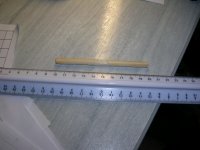 6 reed stick.JPG593.4 KB · Views: 153
6 reed stick.JPG593.4 KB · Views: 153 -
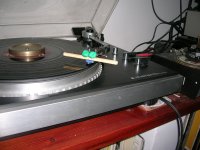 5 Shure+longhorn+2.4gr center mass.JPG619.7 KB · Views: 179
5 Shure+longhorn+2.4gr center mass.JPG619.7 KB · Views: 179 -
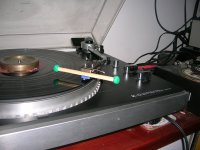 4 Shure+longhorn+2.4gr tip mass.JPG617.3 KB · Views: 163
4 Shure+longhorn+2.4gr tip mass.JPG617.3 KB · Views: 163 -
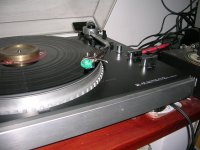 3 Shure + 2.8gr weight.JPG616.3 KB · Views: 283
3 Shure + 2.8gr weight.JPG616.3 KB · Views: 283 -
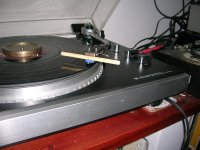 2 Shure + longhorn.JPG608.9 KB · Views: 289
2 Shure + longhorn.JPG608.9 KB · Views: 289 -
 1 Shure.JPG598 KB · Views: 308
1 Shure.JPG598 KB · Views: 308 -
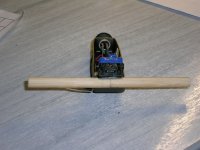 7 Longhorn close-up.JPG614.2 KB · Views: 159
7 Longhorn close-up.JPG614.2 KB · Views: 159
George: That Shure close up is interesting as the elastomer is only on 2 sides of the inner tube, so relies on being biased by the VTF. Different from the ortofon circular elastomer, but possibly easier to mod...
Hi Bill
The elastomer is on the four sides but it’s much thicker on the two upper sides.
When the time for dissecting will come, I will check to see if the inner construction is like US 4194744 Figs 10 to 14
George
- Home
- Source & Line
- Analogue Source
- Turntable speed stabilty


